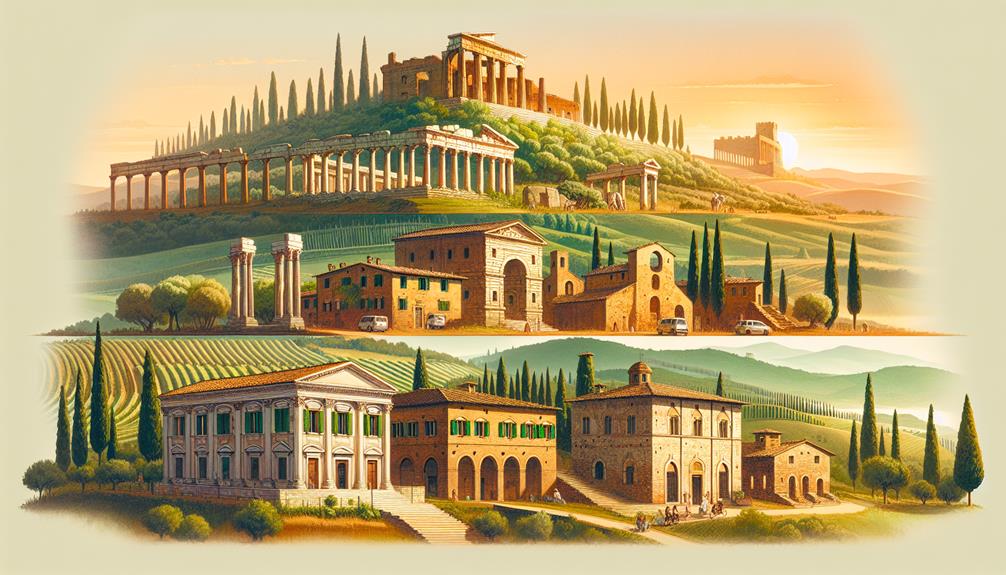Embark on an architectural journey through time in Tuscany. Witness the Etruscans’ mastery in engineering with structures like Volterra’s walls and Cerveteri’s tombs. Roman influence introduced arches, vaults, and domes seen in Lucca’s amphitheater and Volterra’s theater. Experience the Roman era’s grandeur with brick and stone structures. Medieval times embraced Gothic elements. Renaissance brought back Roman and Greek architectural features. Baroque and Neoclassical periods added ornate decorations. Modern styles blend tradition with contemporary designs, emphasizing clean lines, open spaces, and sustainable practices. Discover the fascinating blend of ancient wonders and modern interpretations in Tuscan architecture.

Ancient Tuscan Architectural Wonders
When exploring the ancient Tuscan architectural wonders, you’ll be captivated by the intricate blend of Etruscan, Roman, and medieval influences that have shaped the region’s unique built heritage. The Etruscans, who settled in Tuscany around the 9th century BC, were known for their advanced engineering skills, creating structures like the impressive walls of Volterra and the intricate tombs of Cerveteri.
As the Roman Empire expanded, Tuscan architecture evolved, incorporating elements such as arches, vaults, and domes. This can be seen in iconic structures like the amphitheater in Lucca and the Roman theater in Volterra.
During the medieval period, Tuscan architecture continued to flourish, with the construction of towering cathedrals and imposing fortresses. The Cathedral of Santa Maria del Fiore in Florence, with its distinctive dome designed by Filippo Brunelleschi, stands as a reflection of the innovation and grandeur of this era.
These ancient Tuscan architectural wonders not only showcase the skill and artistry of their creators but also provide a glimpse into the rich history and cultural tapestry of the region.
Evolution of Tuscan Design Styles
How did Tuscan design styles evolve over time, reflecting the changing influences and cultural shifts in the region’s architectural landscape? The evolution of Tuscan design styles can be traced through distinct periods that have left their mark on the architectural heritage of the region.
During the Roman era, Tuscan architecture was characterized by the use of brick and stone, with a focus on grandeur and symmetry. The influence of Roman design principles can still be seen in many Tuscan buildings today.
In the medieval period, Tuscan architecture embraced elements of Gothic style, with pointed arches, ribbed vaults, and flying buttresses becoming prominent features in churches and civic buildings.
The Renaissance marked a return to classical ideals, with a revival of Roman and Greek architectural elements. This period saw the emergence of elegant palaces, churches, and villas adorned with columns, pediments, and harmonious proportions.
The Baroque and Neoclassical periods introduced ornate decorations, elaborate facades, and intricate details to Tuscan architecture, reflecting the artistic trends of the time. Today, Tuscan design styles continue to evolve, blending tradition with modern influences to create a unique architectural landscape that pays homage to the region’s rich heritage.
Modern Interpretations of Tuscan Architecture
Modern architects have reimagined Tuscan architectural traditions by infusing contemporary elements into the classical design principles, creating a dynamic fusion of past and present aesthetics. This modern interpretation of Tuscan architecture often focuses on clean lines, open spaces, and a harmonious integration with nature. One prominent feature is the use of materials like glass and steel alongside traditional Tuscan elements such as terracotta roof tiles and stone walls.
In modern Tuscan architecture, there’s a deliberate effort to create a seamless indoor-outdoor connection, with large windows and open floor plans that invite natural light and ventilation. Sustainability is also a key consideration, with architects incorporating eco-friendly technologies and practices into their designs. This approach honors the Tuscan tradition of living in Harmony with the environment.
Exploring the Architectural Wonders of Tuscany
Tuscany’s architectural landscape is a splendid tapestry that weaves ancient history with modern design, showcasing structures that tell tales of cultural evolution and artistic mastery. From the rustic farmhouses scattered across rolling hills to the innovative contemporary buildings that punctuate its cityscapes, Tuscany offers a visual feast for architects and history buffs alike. To truly immerse yourself in the beauty of Tuscan architecture and live amidst these historical gems, consider a stay in one of the tuscany italy villas. These villas provide not only luxury and comfort but also a perfect base from which to explore the region’s architectural heritage.